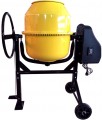Gear ring material
The material from which the
crown is made. It matters not so much in terms of the quality of concrete mixing, but in terms of the durability of the equipment.
—
Cast iron. The most common metal in the manufacture of the crown. Easily processed, quickly cast, characterized by minimal investment at all stages of production. Another notable feature of cast iron is its long service life. At the same time, under mechanical stress, the cast-iron crown can crack, and all kinds of abrasive particles crumble rubbing places. In operation, the crown of cast iron often rattles and vibrates.
—
Steel. High-strength crown material. Steel is more expensive than cast iron, which is more than offset by silent operation. Steel rim cement mixers are great for many hours of daily use.
—
Polyamide. The manufacturing technology of polyamide crowns is based on a synthetic composition endowed with elasticity and resistance to temperatures in a wide range. Rims made from this composite material are notable for their durability, lightweight design, smooth running and quiet operation. The polyamide crown can be partially changed — usually it consists of four parts and one worthless one can be easily replaced.
Drum capacity
The total volume of the working drum of the cement mixer. The amount of solution that can be prepared in the device at a time directly depends on this parameter. Accordingly, it is worth choosing a model according to the volume of the drum depending on the scale of the proposed work — the more concrete is needed and the more people are involved in the process, the larger the cement mixer should be. At the same time, it does not always make sense to chase the maximum capacity — after all, such models are not only rather bulky and high consumption, but also expensive.
Also note that you should not confuse the total volume with the amount of mixture prepared at a time: since the drum is never completely filled, its working volume, by definition, will be lower than the total (for more details, see "Volume of the finished mixture"). However, when choosing a model, depending on the scale of work, it is customary to focus on the total volume of the drum. So, the best option for a team of 4 – 5 workers is most often called 150 – 180 liters, and for small construction by one person —
about 50 – 70 liters. More detailed recommendations can be found in specialized manuals.
Max. power
The power of the motor used to rotate the working mechanism of the cement mixer. This parameter can be called secondary, because. it is selected depending on the volume of the drum (see above) — in such a way as to ensure rotation without problems at the maximum working load (see "Volume of the finished mixture"). And the main criterion when choosing a cement mixer is still the volume of the drum. However, models of equal volume may vary in power, and to determine the optimal option, it is necessary to take into account the planned operating conditions.
So, the "ceiling" in terms of power for small cement mixers with a volume of up to 130 liters, designed for use in individual construction, is 700-800 W — this is quite enough for normal operation without excessive electricity costs. If you need continuous operation for 10 hours or more, you should pay attention to more powerful models. It is also recommended to have a power reserve if the cement mixer has to be used with unstable networks where voltage drops are possible.

